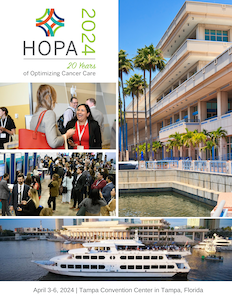Back
Trainee Research
Category: Pharmacist Roles
(057) Descriptive Comparison of Oral Chemotherapy Medication Management Programs at an Academic Health System
Friday, April 5, 2024
12:00 PM – 2:00 PM ET
- AQ
Anthony C. Quach, PharmD (he/him/his)
PGY2 Oncology Pharmacy Resident
UC San Diego Health
San Diego, California, United States
Presenting Author(s)
Poster Abstract: With the rapidly growing number of approved oral chemotherapies for various malignancies, there is an increasing need for enhanced follow-up in the ambulatory care setting to provide patient-centered care for individuals receiving these treatments. Pharmacists can provide valuable services such as medication counseling, evaluation of adverse drug effects, supportive care management, medication reconciliation, and review of drug-drug interactions. However, the varied ways of implementing pharmacist roles in this context make it unclear which approaches result in more comprehensive outcomes. In this study we compared two different medication management programs implemented at an academic health system, providing a descriptive analysis of their structures, processes, and outcomes. Through this investigation, we aimed to offer insight into the impact of a dedicated oral chemotherapy follow-up program on patient outcomes and financial savings to the institution.
Our primary objective was to characterize and compare pharmacist interventions for oral chemotherapy patients participating in a telehealth medication follow-up program versus those managed by a specialty pharmacy within the same academic health system. Our secondary objectives were to assess and compare the clinical and financial outcomes between these two medication management programs.
This was a single-center retrospective descriptive study that included patients aged 18 and over with breast cancer prescribed abemaciclib or capecitabine as well as those with gynecologic cancer prescribed olaparib, niraparib, or lenvatinib from January 2021 to August 2023. Medication fill histories and pharmacist interventions (such as medication counseling, prevention and management of adverse drug effects, and drug-drug interaction review) were reviewed from the health system’s electronic medical record and compared between groups. Outcomes, such as the mean length of days to first dose reduction, mean length of days on oral chemotherapy, and emergency room visits/hospital admissions due to oral chemotherapy-related adverse events, were evaluated between groups. Additionally, a cost avoidance analysis was conducted to compare financial savings to the institution resulting from pharmacist interventions.
Data collection is ongoing, and results are pending. Although results are pending, we anticipate this study to provide insight for future research on how oncology pharmacists in the ambulatory care setting can optimize their roles, workflows, and processes to improve outcomes.
References (must also be included in final poster): 1) Wong SF, Bounthavong M, Nguyen CP, et al. Outcome Assessments and Cost Avoidance of an Oral Chemotherapy Management Clinic. J Natl Compr Canc Netw. 2016;14(3):279-285
2) Mae Trinidad D, Patel PR. The Impact of an Embedded Oncology Pharmacist in an Outpatient Oncology Center in the Treatment of Hematologic Malignancies. J Adv Pract Oncol. 2022;13(7):673-682
3) Randolph LA, Walker CK, Nguyen AT, et al. Impact of pharmacist interventions on cost avoidance in an ambulatory cancer center. J Oncol Pharm Pract. 2018;24(1):3-8
4) Lee AJ, Boro MS, Knapp KK, et al. Clinical and economic outcomes of pharmacist recommendations in a Veterans Affairs medical center. Am J Health Syst Pharm. 2002;59(21):2070-2077
5) Mull A, Hawkins C, Punke A, et al. Clinical and economic impact of oncology-trained pharmacist integration in an ambulatory cancer clinic. J Oncol Pharm Pract. Published online September 20, 2023
6) Darling JO, Raheem F, Carter KC, et al. Evaluation of a Pharmacist Led Oral Chemotherapy Clinic: A Pilot Program in the Gastrointestinal Oncology Clinic at an Academic Medical Center. Pharmacy (Basel). 2020;8(1):46
Our primary objective was to characterize and compare pharmacist interventions for oral chemotherapy patients participating in a telehealth medication follow-up program versus those managed by a specialty pharmacy within the same academic health system. Our secondary objectives were to assess and compare the clinical and financial outcomes between these two medication management programs.
This was a single-center retrospective descriptive study that included patients aged 18 and over with breast cancer prescribed abemaciclib or capecitabine as well as those with gynecologic cancer prescribed olaparib, niraparib, or lenvatinib from January 2021 to August 2023. Medication fill histories and pharmacist interventions (such as medication counseling, prevention and management of adverse drug effects, and drug-drug interaction review) were reviewed from the health system’s electronic medical record and compared between groups. Outcomes, such as the mean length of days to first dose reduction, mean length of days on oral chemotherapy, and emergency room visits/hospital admissions due to oral chemotherapy-related adverse events, were evaluated between groups. Additionally, a cost avoidance analysis was conducted to compare financial savings to the institution resulting from pharmacist interventions.
Data collection is ongoing, and results are pending. Although results are pending, we anticipate this study to provide insight for future research on how oncology pharmacists in the ambulatory care setting can optimize their roles, workflows, and processes to improve outcomes.
References (must also be included in final poster): 1) Wong SF, Bounthavong M, Nguyen CP, et al. Outcome Assessments and Cost Avoidance of an Oral Chemotherapy Management Clinic. J Natl Compr Canc Netw. 2016;14(3):279-285
2) Mae Trinidad D, Patel PR. The Impact of an Embedded Oncology Pharmacist in an Outpatient Oncology Center in the Treatment of Hematologic Malignancies. J Adv Pract Oncol. 2022;13(7):673-682
3) Randolph LA, Walker CK, Nguyen AT, et al. Impact of pharmacist interventions on cost avoidance in an ambulatory cancer center. J Oncol Pharm Pract. 2018;24(1):3-8
4) Lee AJ, Boro MS, Knapp KK, et al. Clinical and economic outcomes of pharmacist recommendations in a Veterans Affairs medical center. Am J Health Syst Pharm. 2002;59(21):2070-2077
5) Mull A, Hawkins C, Punke A, et al. Clinical and economic impact of oncology-trained pharmacist integration in an ambulatory cancer clinic. J Oncol Pharm Pract. Published online September 20, 2023
6) Darling JO, Raheem F, Carter KC, et al. Evaluation of a Pharmacist Led Oral Chemotherapy Clinic: A Pilot Program in the Gastrointestinal Oncology Clinic at an Academic Medical Center. Pharmacy (Basel). 2020;8(1):46

